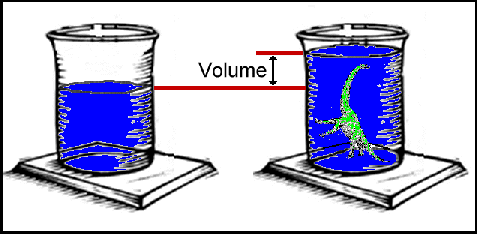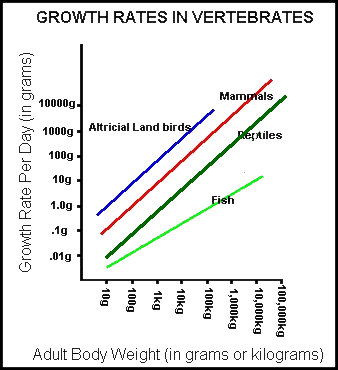
Lab 7: Dinosaur Paleobiology
Objectives: The goal of this lab is to examine aspects of dinosaur paleobiology. You will assess the mass of the large sauropod brachiosaurus and then estimate its possible lifespan based on its growth rate.
Background: Brachiosaurus was one of the largest animals to have ever lived with a length approaching 100 feet. It was a Jurassic dinosaur that inhabited the North American continent over 100 million years ago. How do we determine how massive brachiosaurus was and its potential lifespan?
Strategy: A reasonable estimate of a dinosaur's mass can be obtained by placing a good scale model in water and determining the volume of water displaced. The scale model provides us with a volume estimate of the amount of soft anatomy that is not regularly preserved. We assume in the estimate that the density of the dinosaur was similar to that of water, which is reasonable in the case for reptiles (1 gram per cubic centimeter). The mass of displaced water can then be scaled to the proportions of the actual dinosaur.

Si
Lets try it.... In our example, the brachiosaurus model is 12 inches long. Since brachiosaurus was approximately 100 feet long and our model is 1 foot long, the scale is 1:100 (1/100th the size of the fossil skeleton).
This is the linear scale for the dinosaur. In order to determine how the volume compares between the model and the real brachiosaur we have to determine the cubic scale of the model. In other words, volume works in 3 dimensions so we need to adjust the 1/100 difference in all 3 dimensions. This is done by multiplying 1/100 X 1/100 X 1/100 = 1/1,000,000. That is to say that our model has one millionth the volume of the actual dinosaur.
Question: If we observed that 35.35 milliliters were displaced when we submerged the model brachiosaur, what is a rough estimate of the actual mass of a brachiosaur??
Hints:
1. Start by multiplying the scale factor by the millimeters displaced to see how much a real brachiosaur would displace.
2. Convert the milliliters to liters (divide by a thousand)
3. Determine how many kilograms that represents (multiply by 0.9 kilograms/liter).
4. Determine how many pounds that represents (multiply by 2.2 lbs per kilogram)
5. Determine the number of tons (divide by 2000)
What's your answer??
Estimating the minimum lifespan of Brachiosaurus:
Once you have determined the mass of Brachiosaurus, you can obtain an estimate of its lifespan by finding out how long it would take to get that massive. Below is a table showing the growth rates for various vertebrate groups. The rates are a function of metabolism (e.g., warm-blooded versus cold-blooded).

Using this table estimate the minimum lifespan (in years) for brachiosaurus if:
1. It had a reptilian cold-blooded metabolism (dark green curve)
2. It had a mammalian warm-blooded metabolism (red curve)
Hints: Use your kilogram estimate from above. Then look for where that value hits the curve for reptile and mammal. Draw a line to the other axis (growth rate) and this will tell you how much body mass it could add each day. Then all you need to do is divide the actual mass by how much it could add each day... this is the number of days to get to that size. Divide by 365 for number of years.
What are your answers and how do the two estimates compare ( a warm-blooded brachiosaur versus a cold-blooded one)?